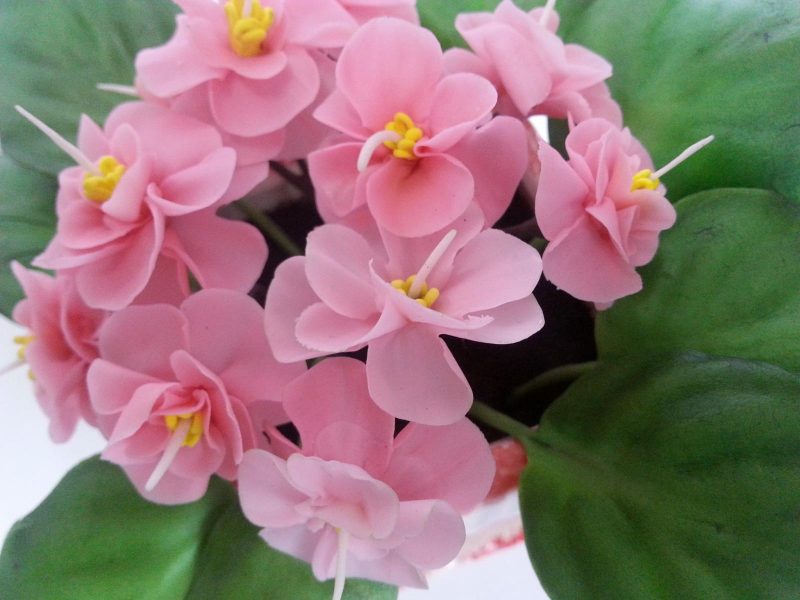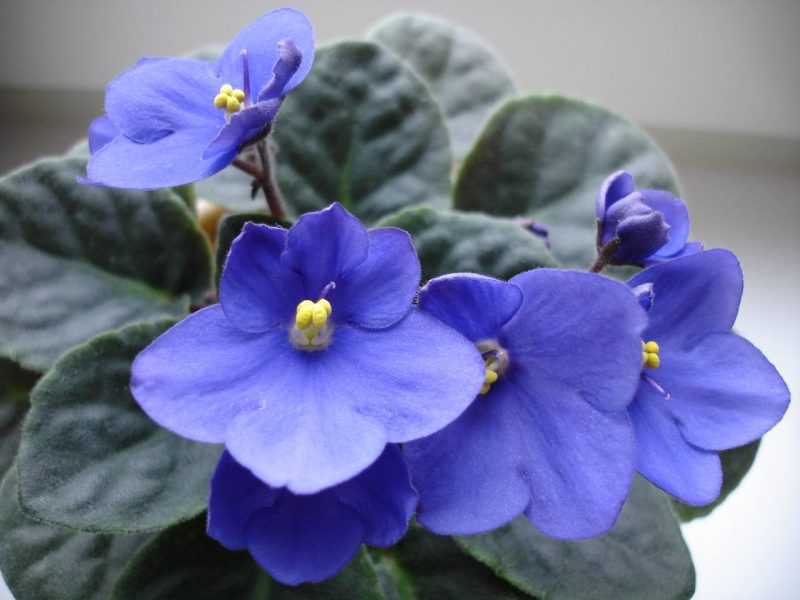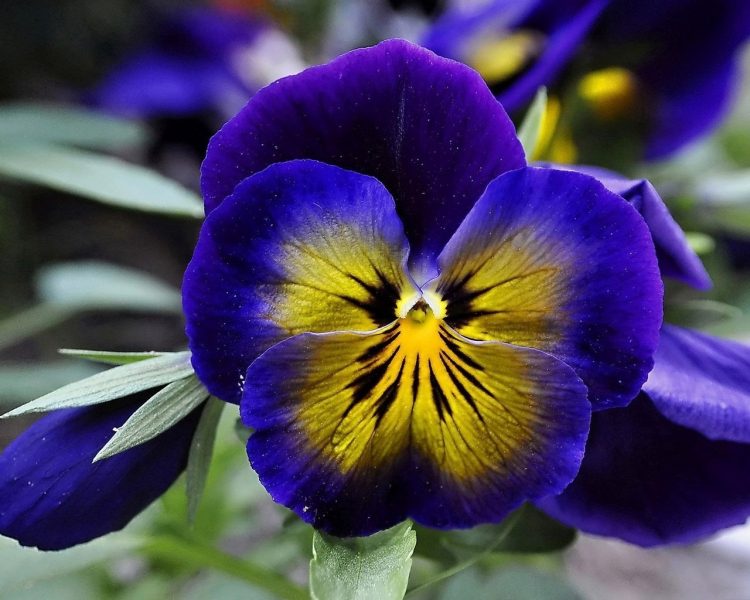The name of Saintpaulia, which is also called violet, is due to the botanist who discovered it in 1893, Saint Paul Iller. It is one of the best plants to grow in a room environment. Violet, home care of which is carried out in compliance with all the rules, pleases the owner with its flowering state from 6 to 10 months a year.
Material Content:
Features of growing violets

The success of the result is affected by the implementation of a number of features of cultivating a room flower:
- Giving the correct shape to the outlet - for this you need to systematically turn the pot clockwise to the sun.
- Creating a compact bush - as the violet grows, carefully cut the lower leaves to get a compact attractive bouquet framed by several rows of green foliage.
- Reproduction or rejuvenation of the old specimen - with an elongated stem and small flowers, it is necessary to cut the leaves to obtain new young plants or to rejuvenate the violet by replanting the rhizome with the two youngest leaves.
- Adding brightness to the flowers - to get brighter flowers, you should pour the senpolia with a solution of potassium permanganate
Home Care

It is not difficult to take care of violets, but you must follow all the rules for keeping the flower in the apartment to get a caressing plant.
Ground and pot requirements
Planting violets is carried out in a pot filled with sifted and calcined in the oven garden soil with the addition of sand. A drainage layer in the form of small expanded clay is placed at the bottom of the landing tank. The pot is selected depending on the variety and age of the flower: for young specimens, dishes with a diameter of 6 cm are suitable, and for an adult twice as much. The root system of even lush plants with large leaves is small, not taking up a lot of potted space.
It is interesting: How to care for violets?
Advice! When choosing a pot, you should be guided by the fact that its diameter should be three times less than that of a violet outlet.
Location and lighting
Throughout the year, the flower needs intense and long-lasting lighting, excluding the flow of direct sunlight. The most suitable place to place a flower pot is the windowsill on the west side of the house.
Attention! With a deficit of light, the flowers will have a faded appearance - elongated leaves, an elongated stalk that violates the shape of the outlet.
Temperature

Senpolia is a cold-resistant culture and is able to survive at low temperatures of 13 ° C, while slowing down life processes, stopping growth and delaying flowering. The optimum temperature range for the normal development of the plant is 20-25 ° C.
Watering and humidity
Watering is carried out 1-2 times a week in the usual way and from saucers. They should not have any residual water after the procedure. It is recommended to use water that has been left standing for a day and 3-4 ° warmer than ambient air: if the difference in temperature values of water and air exceeds 5 °, yellowish spots appear on the sheet plates.
Violet prefers more humid air. To do this, containers with water or wet moss are placed near the flower. Leaf plates do not wash due to moisture retention between the hairs on them.
Attention! Water must not be allowed to fall on the leaves: this leads to the formation of spots, decay and loss of decorativeness.
Fertilizer application

For optimal development conditions, the flower needs double additional nutrition:
- Fertilizing with organic fertilizers in the form of manure at the rate of 1 tablespoon of organics in 5 liters of water.
- The introduction of a complex of mineral fertilizers - 1 teaspoon of superphosphate, potassium sulfate and urea, diluted in 5 liters of water.
Transplant at home
Violet is transplanted once a year in spring, if the plant develops year-round - at least twice at any time of the year. When transplanting old specimens, elongated shoots are buried, on which new roots are formed.
Pests and diseases
Saintpaulia is quite resistant to disease and pest damage. Most often, shoots show signs of late blight - brown spots. Fighting him is almost pointless. The main thing is to prevent the spread of the disease by destroying the diseased specimen and discarding the substrate. The most harmful pest is considered to be nematodes that infect the roots of the plant, because of which the violet stops feeding and dies. The acquisition of a special substrate for growing crops in the store or high-quality calcination of garden soil will help prevent infection of the indoor flower.
Propagation Features

Senpolia is propagated by cuttings, dividing the bush and seed method.
Seed way
The seed method is practically not used due to the complexity and inability to save varietal characters.
Cuttings
Propagation of violets with a leaf is the most common technique, which is carried out regardless of the time of year.
For implementation, you will need:
- Take a well-developed leaf with a petiole and place in water to form roots, and after formation, plant in a pot with a substrate for violets.
- Or place the leaf directly on a substrate of sand, leaf and turf soils in equal parts.
- Cover the container with the ground and a leaf with glass and keep in a warm, well-lit place, but protecting it from direct sunlight.
- Moisten the soil periodically.
If it is noted that the leaf has begun to fade or is not undergoing changes, do not rush to get rid of the material: a new plant may take a long period of time to form.
Bush division
Adult specimens, when they grow, give new sockets: daughter bushes sometimes even oppress the mother.
There is a need to separate the children:
- The daughter outlet is carefully dug out with a short sharp knife so as not to injure the mother instance.
- If a lot of leaves and few roots turn out on a separated bush, then part of the leaf plates is cut off.
- The resulting outlet is planted in a small container filled with the same substrate as in the pot with the mother plant.
- Watering is carried out sparingly, avoiding overflow of a flower.
- The young flower is placed in a warm, lit place under the scattered rays.
Advice! It is better to divide the bush in the summer season, so that the mother plant quickly regains strength and has time to accumulate energy by winter.
Problems in growing crops
In the process of growing a crop, problem situations often arise with related issues, which can only be resolved by determining the cause.
The flower turns yellow leaves
The underlying factor in the problem of growing Saintpaulia is moisture and its excess, which may be caused by:
- non-observance of irrigation rules: overflow, water falling on leaves;
- prolonged drying of the soil;
- excessive deepening of the outlet;
- too large a pot, which causes acidification of the soil;
- Too high or low temperature conditions in the room.
Why don't the violets bloom?

Possible causes and solutions:
- Daylight hours less than 12 hours - it is necessary to organize additional lighting for another 2 hours.
- Excess of light - protect the plant from direct rays.
- Nutrient deficiency - it is necessary to regularly feed the culture.
- The outlet has more than one growth point - stepsons should be removed to make the leaves larger.
- A wide pot - it is worth transplanting the violet into a container of a smaller diameter.
- Excessive air dryness - it is necessary to place a vessel with water near the plant.
- Infestation by pests.
Three-colored violet: care features

The culture better known as pansies has a number of exceptional requirements, primarily related to flowering:
- Lighting - placing pansies in partial shade: when in bright light, the flowers will be larger, but will quickly fade.
- Soil - systematic loosening and weeding of soil with plantings.
- Top dressing - the composition is similar to the nutrition of violets, but they must be carried out in the phase of budding and flowering.
So, the spent efforts and time are more than compensated by the result. For minor troubles, the flower grower will receive a lot of positive emotions from seeing the pots with blooming violets.












